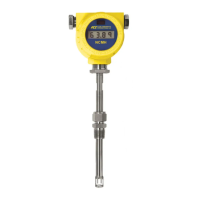Fluid Components International LLC
This page is subject to proprietary rights statement on last page
8 Doc. No. 06EN003367 Rev. E
ST50 Mass Flow Meter
Pulse Output Activation
The ST50 provides an optional pulse output feature. Instruments ordered with this feature and volumetric or mass flow units will be
factory set with totalizer and pulse output activated. The mode can be changed in the field. As required for your application wire the
sink or source output as shown in “Pulse Output Wiring” on the next page.
Source Mode: 15 VDC output, 50 mA max.
Sink Mode: 40 VDC max, 150 mA max., customer supplied power source
Modify the analog output configuration using one of the below listed methods:
1. The RS232 port, a PC/terminal program or FC88 hand held terminal and single letter commands as summarized in Appendix A,
Table 5. Use the “V” menu to configure the instrument analog outputs.
2. The RS232 port, a computer and the CLI commands as summarized in Appendix A, Table 6.
Pulse Output Setup
The ST50 mass flow meter pulse output can be configured for either a pulse train (factory standard) for an external counter and/or
flow rate indication or an alarm. The pulse output can be wired to use a source or sink outputs. The maximum frequency of the pulse
output is 500 Hz. Set up the totalizer first, then configure the sink/source pulse output as required for the application (sink/source
output, pulse factor, sample period and pulse state.
Source mode: In this mode the flow meter electronics supplies the voltage and current for the pulse.
Maximum 15 VDC and 50 mA (depends on the connected load).
Sink mode: If the connected load requires >15 VDC and 50 mA an external power supply is required. Maximum 40 VDC and 150 mA.
Pulse factor: Number of pulses per selected engineering unit. Default = 1
Example in NCMH:
1 = 1 pulse per NCM
0.1 = 1 pulse per 0.1 NCM (10 pulses per 1 NCM)
10 = 1 pulse per 10 NCM
Range pulse factor 0.001 – 1000
Sample time: Time in seconds before calculating the next number of pulses.
Pulse state: Transitions High to Low or Low to High. Meaning the pulse is normally high or low.
Pulse output functions:
Alarm: can be set in Source and Sink mode. If this function is selected the state of the transistor driver changes from high
to low or low to high, depending on the selected pulse state, at a set flow rate. (pulse factor and sample time not
required).
Counter: can be set in Source and Sink mode. The transistor driver outputs the calculated number of pulses* based on the
indicated flow. And external display will indicate the totalized flow.
Flow rate: can be set in Source and Sink mode. The transistor driver outputs the calculated number of pulses* based on the
indicated flow. External display set to calculate flow from incoming pulses.
*Each sample period the number of pulses are calculated and output by the open collector. Any remaining fractional pulse in the calculation will be
added to the next sample. Example:
flow = 90 NCMM (= 1.5 NCMS), Pulse factor =1, sample time is 1.
after 1 second the number of calculated pulses is 1.5, pulse out is 1. Remainder = 0.5
after the next second the number of pulses is 2 (1.5+0.5), pulses out is 2. Remainder = 0
+vdc
0vdc
+vdc
0vdc
High to Low
Low to High
C00956-1

